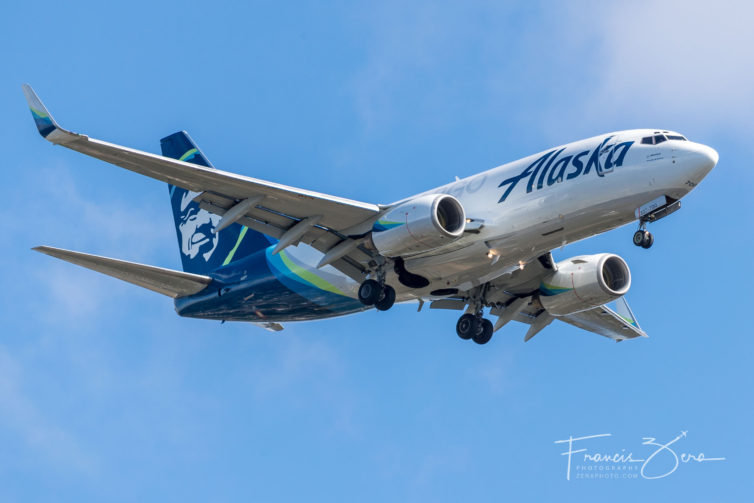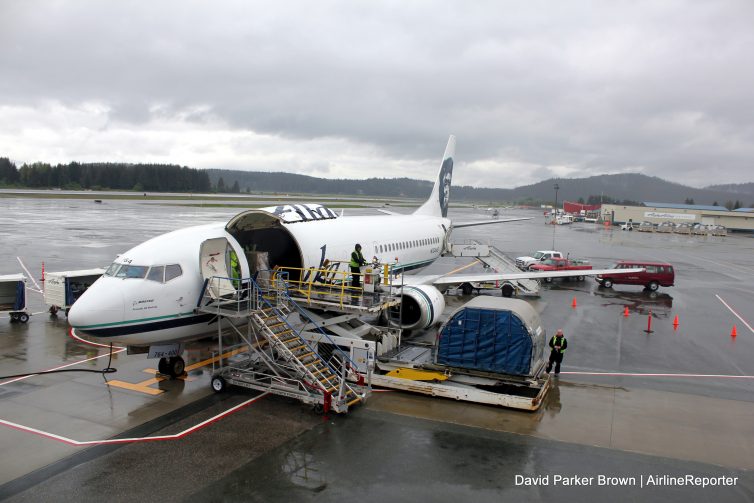
Alaska Airlines’ newly-converted 737-700 freighter on a recent flight from Anchorage to Seattle
Alaska Airlines recently added a new type of aircraft to its fleet: an all-cargo Boeing 737-700, converted from one of their passenger jets.

Alaska’s first completed 737-700 freighter being prepped for paint in Victorville, Calif – Photo: Mike Hogan (manager, Alaska Airlines vendor maintenance)
The conversion was completed in Tel Aviv by Israel Aerospace Industries. The plane was ferried to Israel in 2016, and the conversion process took a total of 19 months. Now that the necessary protocols and systems have been developed, subsequent conversions will be completed at a faster rate.

One of the Alaska 737-400 Combis seen in Juneau, AK
Because the converted jet is the first of its kind, a FAA supplemental type certificate was required, and Alaska earned that certification prior to the converted aircraft’s departure from Israel.
The $15 million order was for three converted freighters, with an option for a fourth. Two conversions are currently underway in Tel Aviv.
In addition to the new cargo jet, Alaska’s previous cargo fleet consisted of one 737-400 freighter and four 737-400 combis, which carry both passengers and cargo. Alaska is the only domestic airline to operate combis, and they plan to retire the last of their 737-400 combi fleet on Alaska Day, Oct. 18, with a flight from Juneau to Seattle.
BONUS: Milk-Run in an Alaska Airlines 737-400 Combi – For Salmon

Tel Aviv to Belfast is not your standard Alaska Airlines routing
Flying from Tel Aviv to Seattle is a bit of a stretch for a 737-700 – the flight was done over two days. On September 6th, Alaska Captains Mark Allman and Bradley Boardman flew the plane from Tel Aviv to Belfast, Northern Ireland, a distance of approximately 2,500 miles.
The flight on September 7th was a bit longer, a 2,786-mile hop across the Atlantic to Bangor, Maine. That flight was about 60 miles shorter than Alaska’s longest regularly scheduled flight, which is from Anchorage to Chicago.

N627AS, Alaska’s 737-700 back in the day when it carried passengers – Photo: My16SidedOffice| FlickrCC
After Bangor, the plane was flown to Greensboro, North Carolina for scheduled maintenance (which was unrelated to the conversion), then on to Victorville, Calif., for paint. After that, it was ferried to Seattle and then up to Anchorage, where it was placed into service at the end of September.
737-700 freighter factoids:
- Nonstop range: 3,200 miles
- Maximum net payload: 42,000 pounds
- Though smaller in size, the 737-700 freighter can carry 10,000 more pounds of cargo per plane compared to Alaska’s current 737-400 freighter.
- The new jet’s tail number is N627AS. Aircraft N626AS and N625AS are currently undergoing the conversion process in Tel Aviv.
Comments are closed here.
Nice, I’m wondering about the payload. You stated that it carries 10,000 more than the 734F, that may be the case versus the 734 combi at 25,000 but the 734F should be different. According to Pemco’s conversions chart https://www.pemcoair.com/conversions/, the 733F has a max payload of 43,000, the 73GF 45,000 and the 734F at 48,000.